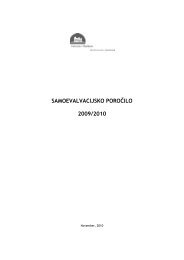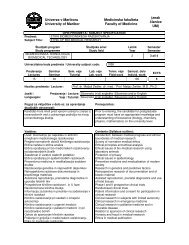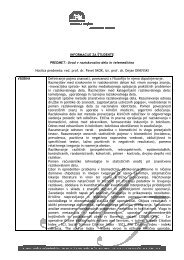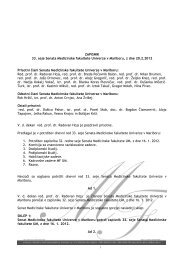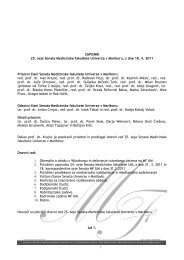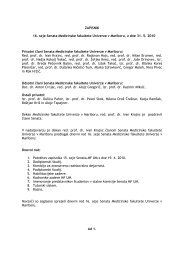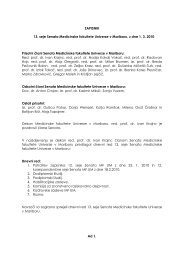opisi predmetov - Medicinska fakulteta Maribor - Univerza v Mariboru
opisi predmetov - Medicinska fakulteta Maribor - Univerza v Mariboru
opisi predmetov - Medicinska fakulteta Maribor - Univerza v Mariboru
- No tags were found...
You also want an ePaper? Increase the reach of your titles
YUMPU automatically turns print PDFs into web optimized ePapers that Google loves.
- konflikt in konfliktnost;- nezaupanje bolnika do zdravnika,obravnave;- strah bolnika pred izgubo vloge, statusa inneodvisnosti;- zanikanje realnosti zdravstvenega problema;- strah pred zapustitvijo domačega okolja;- usmerjenost v bolečino;- strah pred smrtjo;- strah pred pohabljenjem, invalidnostjo;- vpliv religije in kulturne;- svetovanje glede nezdravega življenja;- obravnava rizičnega vedenja (samomorilniposkus);- obravnava agresivnega vedenja- vzpostavitev efektivne komunikacije študent/zdravnik - bolnik na podlagi razumljiverazlage in predstavitve glede ocene,svetovanja, privolitve, pomoči inprilagoditve/priprave]- problem nestrinjanja z bolnikom(najpogostejše ovire uspešnega prepričevanja,tri perspektive zaželjenih odzivov, odziv naugovor)- nebesedna komunikacija (kako pritegnemopozornost z nebesednimi elementi, vizualnovedenje, glasovni elementi, čustvenozaznavanje sogovornika)- komunikacija z osebjem (v timu)- komunikacija z mediji (oblikovanje izjave,najpogostejši odzivi, tehnika prikaza lastnegamnenja, strategija boja in bega)- strateška komunikacija- komunikacija s skupnostjo (preventiva)- krizna komunikacija (stresne razmere)- oblikovanje multimedijskih materialov (zaštudente, bolnike, družbo)- conflict and conflictness- patient's distrust of doctor, treatment- patient's fear of losing his role, status andindependence- denial of the reality of an existing healthproblem- fear of leaving home environment- focus on pain- fear of death- fear of disfigurement, invalidity- religious and cultural influences- counseling about unhealthy lifesyle- managing risk behavior (suicide attempt)- managing aggressive behavior- establishing effective student/doctor –patient communication based oncomprehensible explanation andpresentation regarding assessment,counseling, consent, assistance andadaptation/preparation- the problem of not agreeing with thepatient (the most common obstacles tosuccessful persuasion, three perspectives ofdesired responses, response to objection)- non-verbal communication (how to attractattention with non-verbal elements, visualbehavior, voice elements, emotionalperception of the other party)- communication with co-workers (inside ateam)- media communication (forming astatement, the most common responses,the technique of presenting one's opinion,fight/flight strategy)- strategic communication- community communication (prevention)- crisis communication (stressfulcircumstances)- preparation of multimedia materials (forstudents, patients, society)Temeljni literatura in viri / Textbooks:1. Mark F Bear, Barry W Connors, M. Paradiso. Neuroscience: Exploring the Brain. LippincottWilliams & Wilkins; Third Edition edition (February 1, 2006)2. Bryan Kolb, Ian Wishaw: Fundamentals of Human Neuropsychology. Worth PubliscersIncorporated.2003.3. David H. Barlow: Clinical Handbook of Psychological Disorders. Guilford publications.2001.4. Robert J. Sternberg, R. Wagner: Readings in Cognitive Psychology.Harcourt BraceCollege Publishers. 1998.5. N. Carlson. Physiology of behaviour. Pearson Allyn & Bacon. 1997.6. Thomas G. Plante. Contemporary Clinical Psychology. John Wiley & Sons; 1998.7. Jerry J. Sweet, Ronald H. Rozensky, Steven M. Tovian. Handbook of Clinical Psychologyin Medical Settings.Plenum Pr; 1991.8. Anthony J. Goreczny. Handbook of Health and Rehabilitation Psychology. Plenum Pr;1995.89



